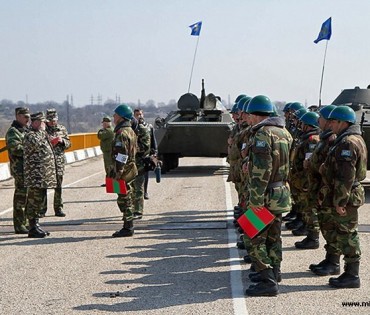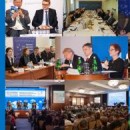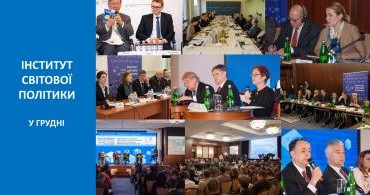Leonid Litra, Senior Research Fellow of the IWP, for “Mirror of the Week”In the Ukrainian society the issue of Transnistria echoes quite often lately. First, the discussion about Transnistria was in the context of Russia’s offensive in Ukraine that might reach the self-proclaimed republic by occupying the southeastern Ukraine. Second, by comparisons about how likely is for occupied Donbas to become a sort of Transnistria. Now, the debate about Transnistria is evolving more towards a possible threat for Ukraine and the potential opening of a second front.
Tiraspol administration and “dughinists” always portrayed Transnistria as a strategic military outpost of the Russian Federation. Yet, the outpost found itself in a difficult situation. As in the case of Donbas in 2014, in the early 1990s Transnistria was promised by their leaders to become a Switzerland, but the reality appeared to be closer to Somalia. The Russian aggression in Ukraine has eroded the status quo in the region and the tension is felt more than ever. The economic situation in Transnistria with about ~70% deficit of GDP is precarious. Out of 700 thousands in the early 1990s the region was depopulated by at least half and the number of pensioners out of those left is about 60%. The economic problems are looming as the social benefits and payments are cut off, the free travel for pensioners in public transport is canceled and most state employees are working on a part-time salary. Most of payments are carried out by Russia that sponsors the region with gas that is not paid, direct funds top-ups for pensions and social allowances and other assistance. Overall, Russia spends at least about 1 billions dollars every year in Transnistria. Now imagine Russia paying the bill for the occupied territory in Donbass which population is about 10 times bigger. Ten billions dollars would be required to keep some very basic living standards, not speaking about how much would be needed to develop the region.
On the background of the rising economic and geopolitical tensions in the region, the Tiraspol administration takes more restrictive measures. The so-called president of Transnistria Evghenii Shevchuk, under the label of fighting the extremism adopted a decision that is directed to oppress any opposition and concentrate the power in his hands. Also, lately he signed a decree that leads to isolation of the region, according to which the citizens of other countries will be entitled to enter the region only by invitation and the entrance will be for fee (however, the so-called MFA of Transnistria specified that the regime of entrance for Ukrainian and Moldovan citizens will remain the same). Russian business also leaves the region. The latest important move is the withdrawal of the Russian billionaire Alisher Usmanov who sold to Transitria the Moldovan Metallurgic Factory and sells other business in region.
About a week ago, a Russian media outlet close to Kremlin published an article that says that the Russian refused to offer Transnistria $100 million. Allegedly the reason is that the Russia is not happy with how the money are spend – highlighting the charter flights of Shevchuk to EU – but also refer to economic problems in Russia. It is not the first time when Russia is declining financial support to the region. At least in public there were 2 other cases involving former leader Igor Smirnov.
In Transnistria understand that the Ukrainian factor and the outcome of the Russian-Ukrainian conflict will be decisive for their existence. Today, the region and the political class are dependent on Ukraine and Moldova. Since Ukraine closed the access for Transnistrian leaders to its territory, these have only one gate to the world that is Chisinau airport.
Currently, Transnistrian authorities are replicating Russian messages and disinformation on the events in Ukraine is widespread. In Transnistria Ukraine is portrayed as threat and potential aggressor, while peace in the region is kept thanks to Russian military presence. The argument of Ukraine as an enemy is boosted by what Transnistrians call (read Russians) a blockade to the region that causes severe economic problems. However, this seem to be cheap political PR aimed at projecting negative image for Ukraine and Moldova, given that the so-called Transnistrian Customs in 2014 regularly reports increase in exports and should a blockade be in place, this would be impossible.
On the other side, many in Ukraine, especially in Odessa, are reflecting on how possible and probable is an attack of Transnistria on Ukraine, having in mind that some 1500 Russian soldiers and up to twelve thousands local soldiers that could be gathered from army and law-enforcement agencies might be used by Russia against Ukraine. The question is indeed serious and one noticed that it is taken as such by Ukraine given the recent deployment of soldiers on the Transnistrian perimeter of the Ukrainian-Moldovan border. However, in the current context and form of the conflict an attack form Transnistria is unlikely, given that it would mean a big trouble for the existence of the self-proclaimed republic. Apparently, the only situation when Transnistria will be militarily used – hopefully such as situation will not occur – is an overt large-scale war of Russia against Ukraine. Also, there are serious doubts that the de-facto authorities would like to engage in any military operations, since they see the terrible footage from Donbas and they better spend their time resting in Europe or Maldives than get into any kind of active conflict. However, who pays orders the music, therefore, if Russia will order then no choice is left. Noteworthy that for those who had nothing to loose and are in still in Russian service like Vladimir Antiufeev and Alexader Caraman have participated the project “Novorossia”.
Having little ground to consider seriously a military confrontation between Transnistria and Ukraine one has to pay more attention to the economic puzzle. Despite the aggressive advocacy of Transnistria to become member of the Eurasian Economic Union, the exports of the region are not matching the political purpose. Transnistrian exports are roughly directed to Moldova (right bank – 40%), EU (35%) and Russia (15%), therefore from economic rationale the drift towards Russia-led union is not understandable. The situation might worsen since the new economic environment will take shape beginning with 2016. Moldova already provisionally implements the deep and comprehensive free trade area with the EU, while Ukraine is programmed also to start implementation as of 1 January 2016. Transnistria was invited and assisted to the negotiations of the DCFTA between Moldova and the EU. Tiraspol’s proposal to have a separate agreement with the EU was declined for obvious reason, but the concession of the EU was that the Autonomous Trade Preferences were prolonged until the end of 2015. If Transnistria decides not to join under the conditions of EU-Moldova Association Agreement, then it will lose the economic preferences with the EU which will hit even harder the region. The new economic-trade reality combined with efforts of Ukraine, Moldova and the EUBAM to counter smuggling to and from Transnistria will significantly change the viability of the region to withstand to economic hardships.
The Tiraspol’s regime unhappiness over the new realities is increasing. The public opinion in Transnistria is divided, but the level of discontent is growing because of worse economic conditions but also disinformation on issues such as “Moldova and Ukraine are preparing to occupy Transnistria” is widespread. Chisinau public opinion is divided as well regarding the region. Moldova’s authorities seem cautious and moderate, as they understand that soon there might be the case of a rapprochement between the two. Moscow also sent some signals that are weakening Transnistria’s position. First, minister Lavrov mentioned in October 2014 that if Moldova loses its sovereignty or changes its status from neutral to bloc status then Transnistria has the right to take a decision about their future independently, which in fact means that the self-determination does not depend on Transnistria as Tiraspol tries to explain, but depends on factors that are not related to the self-proclaimed republic, therefore, confirming that Transnistria is just a tool for Moscow to hold Moldova tight as intended to create the same from Donbas to hold Ukraine. More recently, the deputy minster of Russian MFA Grigory Karasin declared that Transnistria has to become a rayon with a special status within a unitary Moldova.
In principle the statements are not new, but in the current situation these generate different fears and ideas. First which comes to mind is the possible trade-off between the West and Russia on Western recognition of Crimea as a part of Russia in exchange for reintegration of Transnistria with Moldova. The idea is not fresh, given that in 2008 after the Russian-Georgian war Moscow demonstrated propensity to cooperate with the West on Transnistria and between Germany and Russia even a memorandum (Meseberg) was signed. However, West was right to deny trade-offs and ask Russia to present deeds not words, since from the Budapest Memorandum we know how much a document means for Russia. Therefore the idea of a trade-off Crimea – Transnistria is unlikely.
What seems more realistic is the reintegration of Moldova for the sake of getting under control of Russia the entire Moldova. The balance of pro-European and pro-Russian is almost even and there is a growing discontent of the population with the ruling coalition in Chisinau that is highly corrupted. But because the coalition calls itself pro-European and people’s association of them with the EU, the support for European integration is decreasing. Thus, in a reintegrated country, a serious support of Russia combined with a support of citizens from Transnistrian region will lead to control of Moldova and why no (theoretically) a integration into the Eurasian Union, which would certainly be another constrain for Ukraine.
Kyiv should keep always an eye on the developments in the Transnistrian region and maintain a close cooperation with the authorities in Chisinau that are very supportive of Ukraine. The joint cooperation should have as central elements the trade cooperation / implementation of DCFTA, the reform of the peacekeeping mission into a civilian mission with an international mandate and fighting smuggling across the Transnistrian perimeter, because in the mid term the solution is there and it has to be peaceful.




Comments theme
Comments themeComments themeComments themeComments themeComments themeComments themeComments themeComments themeComments themeComments themeComments themeComments themeComments themeComments themeComments themeComments themeComments themeComments themeComments themeComments.